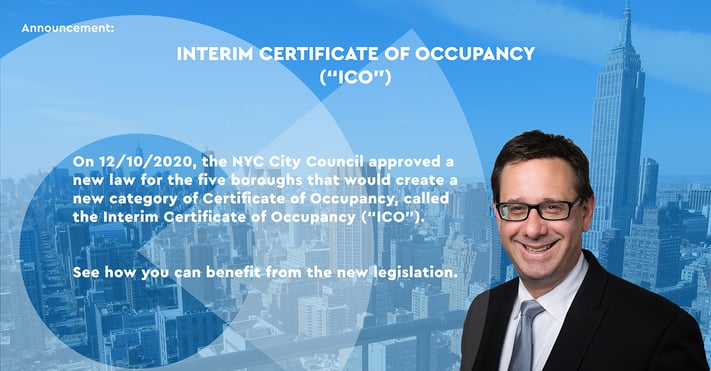
What is it?
On 12/10/2020, the New York City Council approved Intro 2033 of 2020, a law that would create a new category of Certificate of Occupancy (“C of O”) called the Interim C of O (“ICO”) for New York City’s five boroughs. The ICO is essentially the same as the existing category of Temporary C of O (“TCO”), but without an expiration date. It will eliminate the need for an owner to re-apply for TCO every 90 days, and it will free the Department of Buildings (“DOB”) from having to process no-change TCO renewals.
When does it go live?
May 11, 2021.
What is the benefit?
- A reduction in administrative burden. Currently the only option is a TCO which needs to be renewed every 90 days and now the space may be able to achieve the ICO which never expires.
- The ability to segregate status floor by floor. For example in a major alteration or a new building the residential and retail components are occupied in phases and this would allow this to happen more easily.
Is my project eligible and how do I get one?
We expect that Vidaris can apply for an ICO on your behalf under the same rigorous Project Advocate review as initial TCOs. The following is a description based on the legislation that has passed and how the ICO fits with other documents that authorize occupancy.
- What buildings/portions of buildings are eligible for ICO? **
-
- For a building to be considered, we expect the standard TCO requirements such as substantial completion of construction, inspections, and sign offs.
See a detailed list under Section B-3 – “TCO” – in the PDF download below.
For portions of a building to be eligible, we expect typical TCO requirements satisfied in the ICO “areas” plus core buildings systems including life safety systems must be complete and signed off. In addition, this only applies to noncombustible construction. - The ICO will work well for larger mixed use, office, and residential projects. The ICO is NOT available for the following buildings:
- Residential or mixed-use buildings with 3 dwelling units or fewer
- Residential buildings with 7 stories or fewer
- Non-residential buildings with 4 stories or fewer
- Parking structures
- Portions of buildings relying on “temporary measures” for occupancy
- This part of the new law is open to DOB interpretation, but at a minimum we expect that all egress and life safety systems for the ICO areas must be in their permanent forms (i.e. no fire guards or temporary walls)
- We expect there to be situations that both an ICO and a TCO to be issued on the same building under the same application #; we expect further information in the coming months. This is primarily due to the new functionality of the permitting systems.
- For a building to be considered, we expect the standard TCO requirements such as substantial completion of construction, inspections, and sign offs.
For more information on this critical legislation shift, or to schedule Vidaris for a complimentary review of your building, please contact Vidaris’ Code Advisory Team, led by Former Commissioner of Buildings Robert LiMandri, for a complimentary review:
Contact rlimandri@vidaris.com or ca@vidaris.com.
To download a PDF reviewing the new ICO vs other documents that allow occupancy, including: LNO’s, Partial C of O’s, TCO’s, and Final C of O’s, click the button below.
*Note: this is a guidance document developed as of 2/1/2021; the Department will have discretion on what specific circumstances will dictate the standards used to issue an ICO. As with other significant policy changes based on law, we expect that a Service Notice, Buildings Bulletin, or Rule promulgation will be authored by the DOB as we approach the effective date. However, in lieu of more information we expect the following to be allowed.
**Note: reference §28-118.15.1
This blog post is part 1 of 3 in a series reviewing the new ICO.











